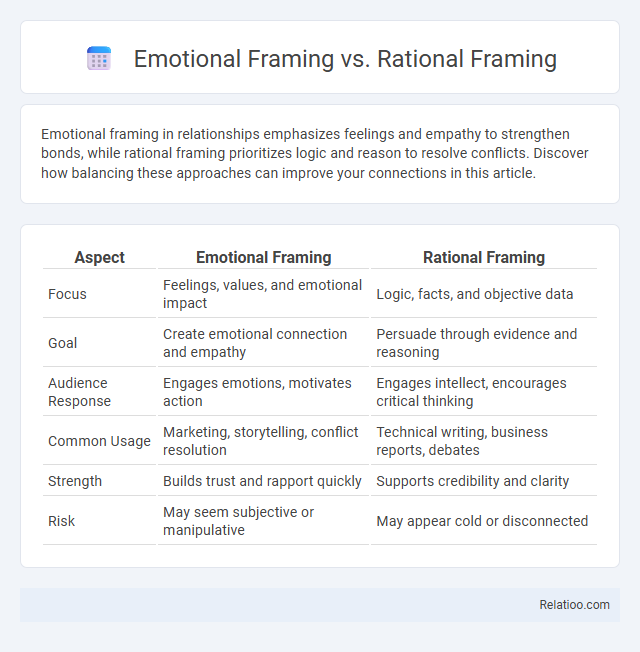Emotional framing in relationships emphasizes feelings and empathy to strengthen bonds, while rational framing prioritizes logic and reason to resolve conflicts. Discover how balancing these approaches can improve your connections in this article.
Table of Comparison
| Aspect | Emotional Framing | Rational Framing |
|---|---|---|
| Focus | Feelings, values, and emotional impact | Logic, facts, and objective data |
| Goal | Create emotional connection and empathy | Persuade through evidence and reasoning |
| Audience Response | Engages emotions, motivates action | Engages intellect, encourages critical thinking |
| Common Usage | Marketing, storytelling, conflict resolution | Technical writing, business reports, debates |
| Strength | Builds trust and rapport quickly | Supports credibility and clarity |
| Risk | May seem subjective or manipulative | May appear cold or disconnected |
Understanding Emotional Framing
Emotional framing leverages feelings to influence decision-making, emphasizing personal values and experiences to create a stronger psychological impact than purely rational arguments. Unlike rational framing, which appeals to logic and data, emotional framing connects with Your audience on a deeper level, often driving quicker and more instinctive responses. Understanding emotional framing enables you to craft messages that resonate, motivate action, and build lasting engagement by tapping into human emotions and empathy.
Defining Rational Framing
Rational framing emphasizes logical reasoning, presenting information through facts, evidence, and clear arguments to influence decision-making. Emotional framing appeals to feelings and values, aiming to connect with your emotions for a stronger impact. Understanding the difference helps you craft messages that either persuade through data or resonate on a personal level.
Key Differences: Emotional vs Rational Framing
Emotional framing leverages feelings such as fear, joy, or empathy to influence decision-making by appealing directly to the audience's affective responses. Rational framing, in contrast, relies on data, logic, and factual information to shape perceptions and guide behavior through analytical reasoning. The key difference lies in emotional framing targeting subconscious, instinctive reactions, while rational framing engages conscious, deliberate thought processes to persuade or inform.
Psychological Impact of Emotional Framing
Emotional framing significantly influences decision-making by activating the amygdala, which heightens emotional responses and biases judgments toward feelings rather than facts. In contrast, rational framing engages the prefrontal cortex to promote logical assessment and analytical thinking based on data and objective information. The psychological impact of emotional framing often results in increased memory retention and stronger motivational drives, leveraging empathy and fear to shape perceptions and behaviors effectively.
Cognitive Effects of Rational Framing
Rational framing influences cognitive processing by presenting information through logical, structured arguments that enhance analytical thinking and reduce emotional bias. This framing technique strengthens decision-making accuracy by encouraging individuals to evaluate evidence and probabilities systematically. Unlike emotional framing, rational framing fosters clearer comprehension and consistent risk assessment in cognitive responses.
Emotional Framing in Advertising and Marketing
Emotional framing in advertising leverages feelings such as happiness, fear, or nostalgia to create strong psychological connections with consumers, enhancing brand loyalty and recall. Unlike rational framing, which relies on logical arguments and factual benefits, emotional framing taps into subconscious motivations and personal values, driving engagement and persuasive impact more effectively. This approach is widely used in marketing campaigns to influence buying decisions by eliciting empathy, trust, and emotional resonance, making products or services more memorable and appealing.
Rational Framing in Decision-Making
Rational framing in decision-making emphasizes logical analysis and objective evidence to evaluate options and outcomes. This approach prioritizes data-driven insights and critical thinking, reducing biases that often arise from emotional influences. By focusing on cost-benefit analysis, risk assessment, and factual accuracy, rational framing enhances clarity and consistency in choosing optimal strategies.
Audience Response to Different Framing Techniques
Emotional framing leverages feelings to create strong audience connections, often leading to more persuasive and memorable responses by tapping into empathy, fear, or joy. Rational framing employs logic and facts, appealing to the audience's analytical thinking and promoting decisions based on evidence and clear arguments. Understanding how audiences respond to emotional versus rational framing enables marketers, communicators, and leaders to tailor messages effectively for engagement, persuasion, and behavior change.
Case Studies: Emotional vs Rational Framing
Case studies comparing emotional framing and rational framing reveal that emotional appeals often drive stronger engagement and decision-making by triggering empathy and personal connection, while rational framing appeals to logic and evidence, influencing choices through clarity and facts. Your marketing strategy can benefit from integrating emotional narratives to enhance brand loyalty alongside rational messages that build trust and credibility. Balancing these framing techniques according to the target audience's preferences and context leads to more effective communication outcomes.
Best Practices for Effective Message Framing
Effective message framing leverages emotional framing by appealing to audience feelings, which enhances message memorability and persuasion, especially in health and marketing contexts. Rational framing complements this approach by presenting clear, logical information and data, supporting informed decision-making and credibility. Best practices involve tailoring the frame to the audience's values, combining emotional and rational elements strategically, and testing message variations to optimize engagement and behavioral impact.

Infographic: Emotional Framing vs Rational Framing
 relatioo.com
relatioo.com